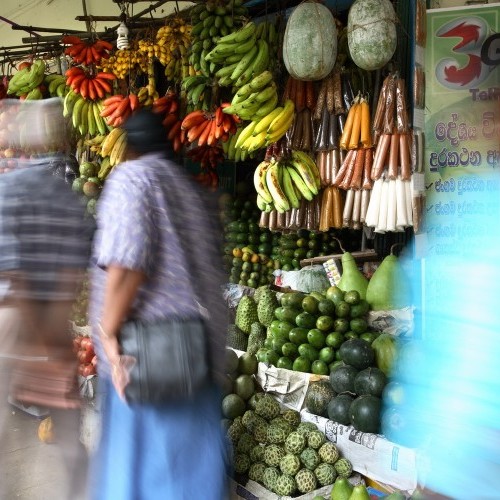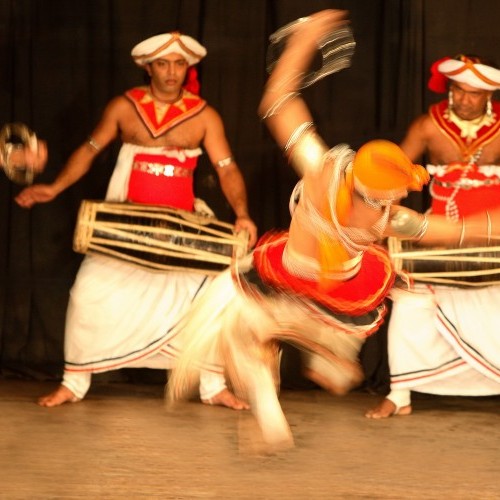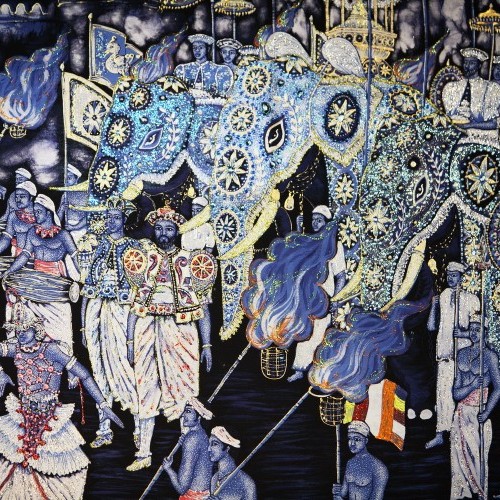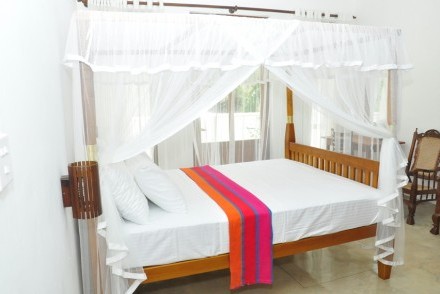Kandy: Site Details
Maha Nuwara ("Great City")
Sites and activities of interest in Kandy include:
- Buddhist Monasteries
- Hindu Devales
- Kandyan Dancers and Drummers
- Royal Palace
- Temple of the Tooth
- Udawattakele Sanctuary
Further afield around Kandy, you may like to visit the following:
- Ceylon Tea Museum
- Peradeniya Botanic Gardens
- Spice Garden
- Three Temples Tour
- Victoria Golf Club

Buddhist Monasteries
Malwatte and Asgiriya Monasteries
Malwatte monastery
Providing an architectural contrast to the Temple of the Tooth with its imposing octagonal tower, the buildings of the Malwatte monastery, the aptly-named "Flower Garden", scale a hillside dotted with woodland paths. Built in the 16th Century to accommodate a delegation of monks from Burma, this is one of the largest monastic establishments in Kandy, with 375 resident monks. Its Assembly Hall (poyage) was decorated in the 18th Century with elegant Kandyan columns supporting a ceiling with painted caissons. It is still used for monastic executive council meetings and the annual ordination ceremonies. The whole complex is an architectural museum in its own right, maintained each year thanks to the donations of Buddhists from all over the world.
Asgiriya monastery
The founding of the Asgiriya monastery dates from the 14th Century. All the sovereigns of Kandy contributed to its image houses. The Adahana Maluwa Gedige, where cremations of royalty took place, is the oldest. Built in the late 15th century, it has the same austere elegance as Natha Devale. During the Esala Perahera, the reliquary of the Tooth is placed here on the last night of the festival, in honour of the mother of King Kirti Sri Rajasinha, whose body was cremated in the monastery. Today nothing remains of the royal burials because those that escaped pillage were destroyed during the construction of the Kandy to Matale railway line (1878-80).
Most of the principal sites of interest can be visited in a 1-hour tour from Kandy.
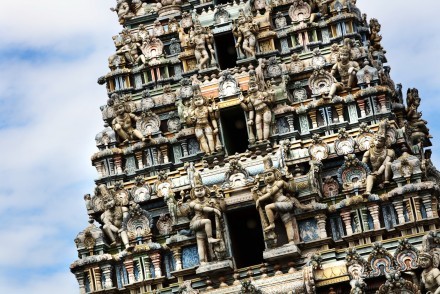
Hindu Devales
Temples of Vishnu, Pattini, Natha and Kataragama
The four Hindu devales (temples), which are perhaps as old as the city itself, are devoted to Vishnu, Pattini, Natha and Kataragama. Interestingly, while Sinhalese Buddhists were in the majority in Kandy, the ancient rulers of the kingdom gave equal prominence to every racial and religious group.
The devale devoted to Lord Vishnu is revered by Buddhists for the role played by that god in the preservation of Buddhism. The devale dedicated to Goddess Pattini, a popular deity who favours chastity and good health, is worshipped by people of all faiths. God Natha is the third deity revered in Sri Lanka. He is venerated for the preservation of faith and nourishment of love and consequently has a special place in the hearts of believers. The god of Kataragama, Skanda, is the fourth deity worshipped for his forthright manner in which he solves problems and gives solace to those who are grieving.
Most of the principal sites of interest can be visited in a 1-hour tour from Kandy.

Kandyan Dancers and Drummers
A National Dance of Sri Lanka
The famed Kandyan dancers are not principally a theatrical performance, but you can see them go through their routines every night in Kandy. These performances are extremely athletic, with great leaps and back flips. The dancers are accompanied by drummers who beat out complex rhythms on the geta bera, a Kandyan tapering double-ended drum - one end is covered in monkey hide and the other with cow hide in order to yield different tones.
This dance form flourished under the Kandyan kings and is today considered the national dance of Sri Lanka. There are four types: pantheru, naiyaki, udekki and ves. In addition there are 18 vannamas (representations in dance of animals and birds). The Ramayana has provided plenty of material for the dances, especially Rama's dash to Lanka to save Sita, aided by the loyal monkey-god Hanuman. But over the centuries other stories have been absorbed, including those about kings and heroes. Under the Kandyan kings, the dance became so beautiful and refined that Buddhist monks admitted it to their temple courtyards and it became an integral part of the great Kandy Esala Perahera.
The best-known costume of male Kandyan dancers is a wide skirt-like garment. The dancer's bare chest is covered with necklaces of silver and ivory, and bangles of beaten silver are worn on the arms and ankles.
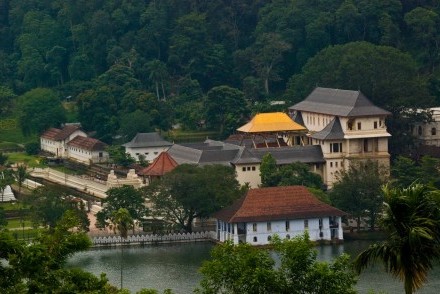
Royal Palace Complex
Sinhalese Architecture and Craftsmanship
The buildings of the Royal Palace complex, consisting of the King's Palace, Queen's Palace, the Audience Hall, the Royal Bathhouse and the Royal Summer House, represent the final flowering of Sinhalese architecture and craftsmanship.
The airy rooms of the Queen's Palace, complete with cloisters and a central courtyard, have been converted into the National Museum, where royal regalia and pre-colonial artefacts are displayed in the rooms where once the courtly concubines lounged. Carved teak columns support the roof and cooling air circulates in its shade.
The surviving portion of the King's Palace now houses the Archaeological Museum, while the intact Audience Hall was where the Kandyan chiefs met to officially capitulate to the British in 1815. The Royal Bathhouse, on the edge of the lake, is a beautiful pavilion with the traditional Kandyan roof, supported by white columns. Today it is a ticket office.
Most of the principal sites of interest can be visited in a 1-hour tour from Kandy.
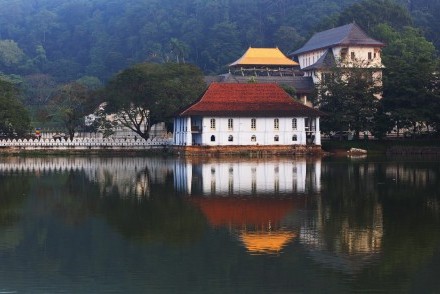
Temple of the Tooth
Dalada Maligawa
The Temple of the Tooth or Dalada Maligawa contains the most sacred relic of Buddhism and the most precious symbol of Sinhalese pride. Carried around by the ancient kings, the sacred tooth relic (a tooth of the Buddha himself) has witnessed and survived all manner of calamities through the ages, including bombing by the LTTE in 1998.
The present Temple of the Tooth was built between 1687 and 1707, with further work carried out during 1747-1782, and restorative work following the bombing still ongoing. Like all buildings destined to house the precious relic, it is a veritable strongbox. The structures visible from the outside comprise an impressive stone rampart enclosing the actual temple, which stands two-storeys high on a platform in the centre of a courtyard. This enclosure wall and the octagonal tower (Patthiruppuwa) in front of the entrance gate date from the last king of Sri Lanka.
Daily puja (blessing) ceremonies are performed at dawn, midday and dusk to the strident wail of Sinhalese pipes and the beat of Kandyan drums. The sacred relic, or more accurately the largest of a diminishing series of caskets or karanduas that enclose the tooth relic itself, can be viewed in the Udmale - upper story - of the Temple.
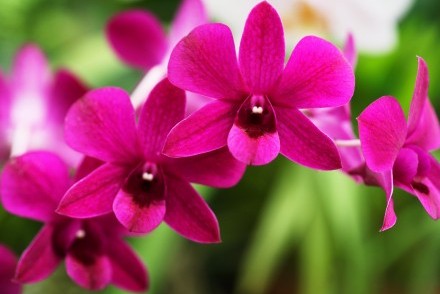
Udawattakele Sanctuary
The Forbidden Forest of the Kings of Kandy
Udawattakele Sanctuary is the "forbidden forest of the kings of Kandy", a royal hunting ground of the erstwhile Kandyan monarchs. Created in 1938, it is a green space of more than 100 hectares in area and extends along the hills to the east of the Asgiriya monastery and behind the Temple of the Tooth. The nature reserve is especially atmospheric in the early morning when the forest, with its aura of miracles and legends, resounds with birdsong. The network of footpaths passes through luxuriant vegetation, populated with monkeys, monitor lizards…and leeches after the rain!
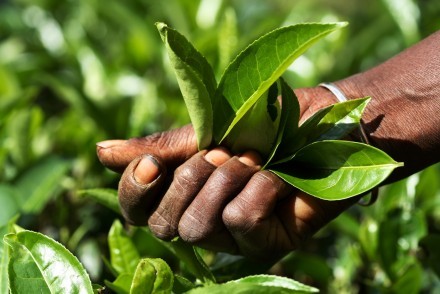
Ceylon Tea Museum
A Monument to the Early Planters
The Ceylon Tea Museum is situated at Hanthana, about 5 km from Kandy, and it is a monument to the courage and fortitude of the early planters who first established tea estates in the 1870s following the devastating failure of coffee. The museum exhibits original machinery used on the tea estates, many still in working order, as well as documents, books, pictures, and other memorabilia and artefacts of historical value to the tea industry.
The rise of Sri Lanka's tea plantations over the grave of the coffee industry in 1869 followed years of experimental planting. The first tea seeds and young plants were brought to the island from the Botanical Gardens in Kolkatta (India) in 1839. James Taylor of Loolecondera (near Kandy), considered as the father of the tea industry in Sri Lanka, first planted tea commercially in 1867, two years before the coffee blight. It was fortunate that the tea grew well, for many coffee pioneers were able to turn the death of the coffee plantations into the birth of an even greater and enduring industry - tea. The first shipment of tea in 1872 was only two small packs containing 23 pounds (10.5 kg) valued at 58 Rupees, a literal drop in the ocean, compared to the 280 million kilograms the country exports today! Sri Lanka is now the largest exporter of tea in the world and boasts the largest tea auction, which has been in operation since 1883.
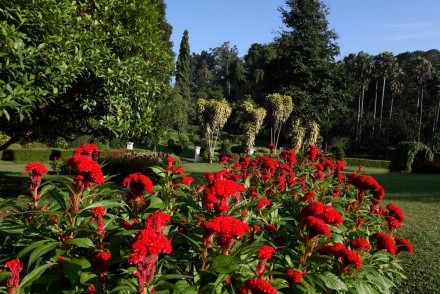
Peradeniya Botanic Gardens
Exotic Tropical Gardens
The site of the gardens of Peradeniya was a seat of power between 1371 and 1377, during the time of the itinerant capitals, although nothing remains from this period today. King Kirti Sri Rajasinha created the gardens and later came to live here. The British made them into the Royal Botanical Gardens in 1821. There are 4000 tropical species, either indigenous or imported, 2000 of which are varieties of trees. The whole site occupies 60 hectares of land and is situated about 6 km from Kandy in a loop of the Mahaweli River.
There are extensive well-kept lawns, an Orchid House containing an outstanding collection, an Octagon Conservatory, fernery, banks of giant bamboo from Burma and numerous flower borders with cannas, hibiscus, chrysanthemums, croton and colourful bougainvillaea. The tank has water plants including the giant water lily and papyrus reeds. You will also see exotic species, especially palms (Palmyra, talipot, royal, cabbage), Ficus elastica (latex-bearing fig or 'Indian rubber tree' with buttress roots), an amazing avenue of drunken-looking Cook's Pines, the enormous canopy of the Java Fig (covering 1600 sq m), and some magnificent old specimen trees. Indian Flying Foxes are resident in the upper branches of some trees, which you will hear chattering away to each other and see hanging upside down or flapping bat-like to and fro.
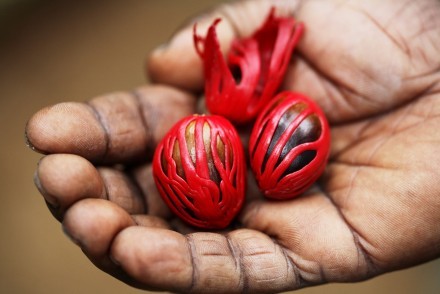
Spice Gardens
Around Matale and Kandy
Most of the spices now seen and used in Sri Lanka were initially introduced from Indonesia by the Dutch or from other spice islands further east by the British. Once the colonial powers realised that Sri Lanka had the ideal climate and environment for growing all kinds of spices, the island became extremely important to them on the maritime trade routes through Asia, and provided great wealth and prosperity to the island's colonisers.
Today the many spice gardens around Matale and Kandy owe their existence to the Europeans need of exotic spices for culinary and medical purposes since the 16th Century. A tour of a spice garden will show you the trees and plants from which the spices and herbs originate, and introduce you to Ayurvedic (traditional) medical cures.

Three Temples Tour
Embekke, Lankathilaka and Gadaladeniya
Kataragama Devale at Embekke, Lankathilaka Viharaya and Gadaladeniya Viharaya are spectacularly situated on top of a small chain of rocky promontories on the edge of a valley carpeted with paddy fields, about 20 km from Kandy. The building of these temples dates from the period of Gampola (1341-1408), one of the itinerant capitals that preceded Kandy.
Kataragama Devale
The Hindu devale, dedicated to the god Kataragama or Skanda, with its sanctuary, Dancing Hall and the Drummers' Hall, is famous for its carved wooden pillars (which may have once adorned the Audience Hall in Kandy) with vibrant figures of soldiers, wrestlers, dancers, musicians, mythical animals and birds. The village has craftsmen working in silver, brass and copper.
Lankathilaka Viharaya
The Lankathilaka Viharaya dominates the paddy fields from a granite plateau. You initially climb up a rock-cut stairway before stepping up to a moonstone at the entrance, and the finely carved wooden doorway flanked by guardian gajasinhas (elephant-lions). An inscription in Pali, engraved in the rock, dates the foundation of this temple to 1344. Its exterior architecture belongs to the tradition of the great gedige of Polonnaruwa, but its ground plan is unusual, as it is a skilful combination of an image house and a devale in one building. The inner image house contains a stuccoed brick statue of the Buddha, whose robe is finely pleated and folded, typical of Kandyan art. The walls and ceiling have well preserved frescoes, which are some of the oldest and best examples of the Kandyan temple style.
Gadaladeniya Viharaya
The Gadaladeniya Viharaya is a small complex built on a granite escarpment. Built of stone (showing influences of Indian temple architecture), it has lacquered doors, carvings and frescoes and a moonstone at the entrance to the shrine. The brick superstructure, shaped like a stupa, has as octagonal base. The inscriptions on the rock by Dharmakirti date it to 1344. The principal gilded image of the Buddha dates from the 18th Century as a replacement for the original which was destroyed by the Portuguese. It is framed by an elaborate makara decoration. Unusually, there is also a shrine to Vishnu here. Outside, there is a covered stupa and a Bodhi tree.
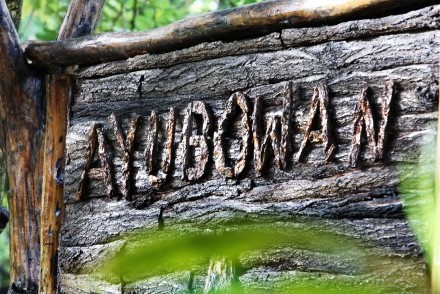
Victoria Golf Course
A Championship Golf Course
The Victoria Golf Course is situated at Digana, which is about 25 km east of Kandy. Located on a 207 hectare site with a 8 km waterfront, it overlooks the panoramic Victoria Reservoir. The Victoria Golf Course is a championship golf course (6190 metres, par 73) designed by Donald Steel and opened in early 1999. Stately trees, including avenues of coconut palms, lend the course an immediate air of maturity. Impressive natural outcrops of rocks are a distinctive feature and indeed a hazard of the course, and the fairways are rather narrow. However, the Victoria Golf Course Golf Architect, Donald Steel, says "Some golf courses have a splendid undulating terrain over which the holes are routed. Some golf courses have a scenic back drop of hills and lakes which excite the senses. However the Victoria Golf Course near Kandy is blessed with both attributes."
A round of 18 holes at the Victoria Golf Course includes green fees, golf balls, and the hire of clubs, shoes and a caddy.

